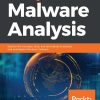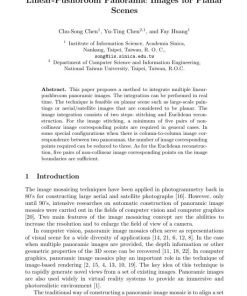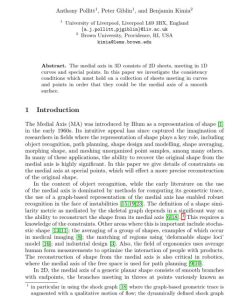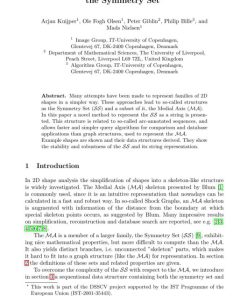Region Based Segmentation on Evolving Surfaces with Application to 3D Reconstruction of Shape and Piecewise Constant Radiance 1st edition by Hailin Jin, Anthony Yezzi, Stefano Soatto ISBN 3540219835 9783540219835
$50.00 Original price was: $50.00.$25.00Current price is: $25.00.
Authors:Hailin Jin, Anthony J. Yezzi; Stefano Soatto , Tags:Computer Vision – ECCV 2004 , Author sort:Hailin Jin, Anthony J. Yezzi & Soatto, Stefano , Languages:Languages:eng , Published:Published:Mar 2004
Region-Based Segmentation on Evolving Surfaces with Application to 3D Reconstruction of Shape and Piecewise Constant Radiance 1st edition by Hailin Jin, Anthony J. Yezzi, Stefano Soatto- Ebook PDF Instant Download/Delivery. 3540219835, 978-3540219835
Full download Region-Based Segmentation on Evolving Surfaces with Application to 3D Reconstruction of Shape and Piecewise Constant Radiance 1st Edition after payment
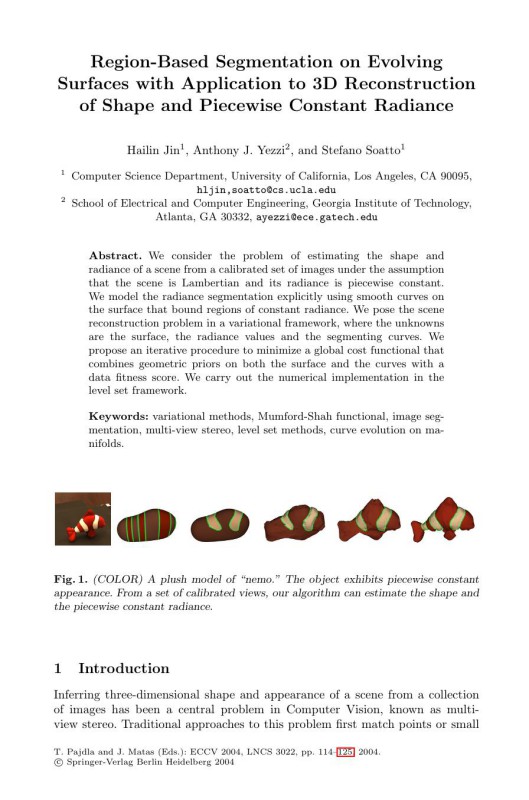
Product details:
ISBN 10: 3540219835
ISBN 13: 978-3540219835
Author: Hailin Jin, Anthony J. Yezzi, Stefano Soatto
We consider the problem of estimating the shape and radiance of a scene from a calibrated set of images under the assumption that the scene is Lambertian and its radiance is piecewise constant. We model the radiance segmentation explicitly using smooth curves on the surface that bound regions of constant radiance. We pose the scene reconstruction problem in a variational framework, where the unknowns are the surface, the radiance values and the segmenting curves. We propose an iterative procedure to minimize a global cost functional that combines geometric priors on both the surface and the curves with a data fitness score. We carry out the numerical implementation in the level set framework.
Region-Based Segmentation on Evolving Surfaces with Application to 3D Reconstruction of Shape and Piecewise Constant Radiance 1st Table of contents:
-
Introduction
- 1.1 Background and Motivation
- 1.2 Challenges in 3D Reconstruction and Surface Segmentation
- 1.3 Importance of Piecewise Constant Radiance in Reconstruction
- 1.4 Objectives and Contributions of the Paper
- 1.5 Structure of the Paper
-
Related Work
- 2.1 Overview of 3D Surface Reconstruction Techniques
- 2.2 Region-Based Segmentation Approaches in Computer Vision
- 2.3 Methods for Modeling Piecewise Constant Radiance
- 2.4 Surface Evolution Models and Their Applications
- 2.5 Limitations of Existing Methods and Open Challenges
-
Mathematical Foundations
- 3.1 Representation of 3D Surfaces and Meshes
- 3.2 Geometric Properties of Evolving Surfaces
- 3.3 Region-Based Segmentation: Definitions and Metrics
- 3.4 Piecewise Constant Radiance: Models and Assumptions
- 3.5 Mathematical Framework for Surface Evolution and Segmentation
-
Region-Based Segmentation on Evolving Surfaces
- 4.1 Overview of Region-Based Segmentation Techniques
- 4.2 Segmentation Criteria on Dynamic Surfaces
- 4.3 Evolution of Surfaces and its Impact on Segmentation
- 4.4 Algorithms for Region Growing and Surface Partitioning
- 4.5 Handling Topological Changes and Singularities during Evolution
-
3D Reconstruction of Shape
- 5.1 Overview of Shape Reconstruction from Surface Data
- 5.2 Surface Reconstruction Algorithms: Marching Cubes, Delaunay Triangulation
- 5.3 Using Segmentation to Enhance Shape Reconstruction
- 5.4 Integrating Region-Based Segmentation with 3D Reconstruction
- 5.5 Case Studies of 3D Shape Reconstruction Using Evolving Surfaces
-
Modeling Piecewise Constant Radiance
- 6.1 Concept of Piecewise Constant Radiance in 3D Environments
- 6.2 Radiance Estimation from Surface Segments
- 6.3 Radiometric Processing Techniques for Surface Segmentation
- 6.4 Applications in Lighting and Appearance Modeling
- 6.5 Handling Variations in Illumination and Surface Properties
-
Algorithm Design and Implementation
- 7.1 Overview of the Proposed Segmentation and Reconstruction Framework
- 7.2 Input Data: Surface Geometry and Radiance Information
- 7.3 Region-Based Segmentation Algorithm Design
- 7.4 Surface Evolution and Reconstruction Pipeline
- 7.5 Computational Complexity and Optimization Considerations
-
Experimental Setup and Evaluation
- 8.1 Datasets and Test Cases for 3D Reconstruction and Segmentation
- 8.2 Evaluation Metrics: Accuracy of Segmentation and Reconstruction
- 8.3 Performance Evaluation: Segmentation Quality and Reconstruction Speed
- 8.4 Comparison with Traditional 3D Reconstruction Methods
- 8.5 Results from Synthetic and Real-World Data
-
Results and Discussion
- 9.1 Visual Examples of Segmentation and Reconstruction Results
- 9.2 Accuracy of Shape Reconstruction with Region-Based Segmentation
- 9.3 Impact of Piecewise Constant Radiance Modeling on Reconstruction
- 9.4 Discussion of Error Analysis and Limitations
- 9.5 Insights and Observations from Experimental Results
-
Applications of Region-Based Segmentation and 3D Reconstruction
- 10.1 Applications in Computer Vision and Object Recognition
- 10.2 Medical Imaging: Reconstruction of Anatomical Structures
- 10.3 Robotics and Path Planning using 3D Shape Reconstruction
- 10.4 Virtual Reality and Augmented Reality Applications
- 10.5 Applications in Cultural Heritage and Archaeology
-
Challenges and Future Directions
- 11.1 Robustness to Noise and Missing Data in Real-World Datasets
- 11.2 Handling Complex Surface Topologies and Deformations
- 11.3 Real-Time Processing for Dynamic Environments
- 11.4 Integration with Deep Learning for Improved Segmentation and Radiance Estimation
- 11.5 Future Research Directions in Surface Evolution and 3D Reconstruction
-
Conclusion
- 12.1 Summary of Key Contributions and Findings
- 12.2 Practical Implications of Region-Based Segmentation in 3D Reconstruction
- 12.3 Limitations of Current Work and Areas for Improvement
- 12.4 Closing Remarks and Future Work
People also search for Region-Based Segmentation on Evolving Surfaces with Application to 3D Reconstruction of Shape and Piecewise Constant Radiance 1st:
explain region based segmentation
thresholding region based segmentation
region-based segmentation in digital image processing
explain about region based segmentation
watershed based segmentation and region merging


